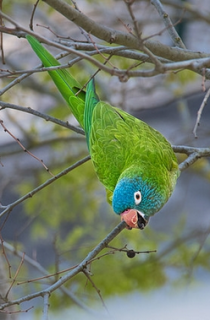Blue-crowned Conure |
|
|
Also known as: Blue-crowned Parakeet, Sharp-tailed Conure
Photos
View in GalleryDid You Know?
This species is the only Psittacara conure with a blue forehead and crown.Academic Research
Related publications: Psittacara acuticaudatusSpecies Profile
Genus: Psittacara | Species: acuticaudatus
Size:
37cm (14.4 in)
Weight:
165g (5.8 oz)
Subspecies including nominate:
five: P.a. acuticaudatus, P.a. neumanni, P.a. haemorrhous, P.a. koenigi, P.a. neoxena
Colour Adult:
P.a. acuticaudatus: Both adults forecrown to lores, cheeks, and ear coverts dull blue; breast on some birds washed blue; tail green on upperside and brown/red on underside tipped with yellow/olive; upper mandible horn in colour tipped with grey, lower mandible grey/brown. Eye ring bare and creamy white. Eye orange.
P.a. neumanni: Both adults forehead to nape blue; underparts suffused dull blue.
P.a. haemorrhous: Both adults as in neumanni, but paler blue confined to forehead and forecrown; blue suffusion absent on underparts; both mandibles horn in colour.
P.a. koenigi: As in neumanni but undertail less brown/red; smaller in size.
P.a. neoxena: As in haemorrhous, but underparts washed with blue; smaller in size.
Colour Juvenile:
P.a. acuticaudatus: As in adults but blue confined to forecrown; no blue wash on breast; tail shorter. Eye brown.
P.a. neumanni: As in adults but tail shorter and eye brown.
P.a. haemorrhous: Blue found on forehead only, or instead a red/brown tinge; tail shorter. Eye brown.
Call:
Calls made in flight loud and repetitious. Also babbling and musical notes.
More Information:
Content Sources:
CITES
BirdLife International
Cornell Lab of Ornithology/Birds of the World
Parrots: A Guide to Parrots of the World, Juniper and Parr, 1998
Parrots of the World, Forshaw and Cooper, 1977. 2010 edition
Parrots of the World, Forshaw, 2006.
Parrots in Aviculture, Low, 1992.
Lexicon of Parrots, Thomas Arndt.
Psittacine Aviculture, Schubot, Clubb and Clubb, 1992
UNEP-WCMC CITES Trade Database, January 2005.
Photos
View in GalleryDid You Know?
This species is the only Psittacara conure with a blue forehead and crown.Academic Research
Related publications: Psittacara acuticaudatusSpecies Care
Captive Status:
Common in US, less so elsewhere.
Longevity:
30-40 yrs
Housing:
Aviary or suspended enclosure, minimum length 3m (9.8 ft).
Diet:
Cooked beans and pulses, boiled maize or corn; sunflower seed, dry, soaked or sprouted; fruit such as: apple, orange, bananas, cactus fruits; rearing food made with hard-boiled egg, wholegrain bread and carrot, all ground to crumbly consistency; vegetables such as: carrot, celery, green beans and peas in the pod; spray millet; complete pellet.
Enrichment:
Socialization, bathing, toys such as ladders, swings, puzzle toys, foraging toys, bird-safe chew toys.
Nest Box Size:
12" x 12" x 18" (30.5cm x 30.5cm x 46cm) vertical box or 10" x 16" x 12" (25.4cm x 40.6cm x 30.5cm) diagonal box.
Clutch Size:
3
Incubation Time:
23-24 days
Fledging Age:
7-8 weeks
Hatch Weight:
Not recorded.
Peak Weight:
Not recorded.
Weaning Weight:
Not recorded.
Photos
View in GalleryDid You Know?
This species is the only Psittacara conure with a blue forehead and crown.Academic Research
Related publications: Psittacara acuticaudatusSpecies Wild Status
World Population:
Unknown, decreasing.
IUCN Red List Status:
Least Concern
CITES Listing:
Appendix II
Threat Summary:
Not globally threatened. Trade has been heavy: 193,299 wild-caught birds were traded internationally from 1981. Race neoxena at high risk from trade and predation by rats with only 100-200 individuals remaining.
Range:
P.a. acuticaudatus: E Bolivia and SW Mato Grosso, Brazil, to Paraguay, W Uruguay and N Argentina, south to La Pampa and SW Buenos Aires. Introduced to Florida and S California, US.
P.a. neumanni: highlands on E slopes of Andes in Cochabamba, Santa Cruz, Chuquisaca, and possibly Tarija, S Bolivia.
P.a. haemorrhous: NE Brazil in Piaui and N Bahia.
P.a. koenigi: NE Colombia, from Guajira Peninsula and Santa Marta Mountains south to W Meta, and N Venezuela, from NW Zulia to Falcon and N Lara, and Aragua east to N Monagas and south to N Bolivar and southern Apure.
P.a. neoxena: Margarita Island, N Venezuela.
Habitat:
Found in dry deciduous forest and other open habitats including semi-desert. Seen in caatinga and cerrado with stands of Mauritia and Buriti palms in NE Brazil, from gallery forest in Venezuela and Colombia, almost desert in Bolivia and pampas in Argentina. Up to 2600m (8528 ft).
Wild Diet:
Food items include Sorghum and Bambusa seeds, berries of Condalia lineata and fruits of cacti and crops such as mango and sorghum. Also takes insects and weed seeds.
Ecology and Behaviour:
Feeds in trees and on the ground, in pairs, or small flocks; congregations larger when food abundant. In some areas birds roost in crevices on cliffs. May be seen with Mitred Conures (Aratinga mitrata) and White-eyed Conures (Aratinga leucophthalma).
Clutch and Egg Size:
3 rounded eggs, 33.0 x 24.0mm (1.3 x 0.9 in)
Breeding Season:
December, Paraguay and Argentina; March-July Venezuela; May-August, Margarita Island. Nest is in tree hollow.
Related Links:
Photos
View in GalleryDid You Know?
This species is the only Psittacara conure with a blue forehead and crown.Academic Research
Related publications: Psittacara acuticaudatusMembers Only Resources
Please log-in now to find more research, resources and tools.
Not a Member?
Find more great information:
Gain exclusive access to 600+ pages of additional research, seminars and podcasts, specialists to ask your toughest questions, and dozens of other fun resources - when you become a WPT member.
Join Today >>

































